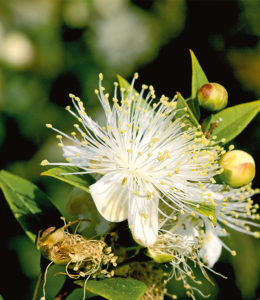
Find out more about the Common myrtle plant of our Aromatherapy Herbarium blog series.

COMMON MYRTLE
Myrtus communis
DESCRIPTION

Myrtle (Myrtus communis) is a shrub from the Myrtaceae family, native to the Mediterranean basin, which grows in the wild in dry and sunny scrubland.
ADVICE
DO NOT USE IN
– pregnant or breast-feeding women,
– children under the age of six years,
– persons allergic to one of the components (geraniol, linalool, limonene),
– subjects with asthma without the advice of an allergologist before the first use,
– over a long period in persons with functional kidney failure (monoterpenes).
RECIPES
Bronchitis
Work in some drops of essential oil of myrtle under the sole of the feet, thorax and sides of the neck, morning and evening for a week.
Spasmodic enterocolitis
Take 2 drops of essential oil of myrtle on a neutral tablet; repeat two to four times during the day.
Haemorrhoids
5 to 10 drops of EO of myrtle, 10 ml of neutral CO. Dilute the essential oil in the carrier oil. Apply a few drops on the haemorrhoids.
Smoker’s cough
1 drop of essential oil of myrtle on a handkerchief stops the coughing fit of smokers.
Productive cough
Pour 2 drops of essential oil of cineol green myrtle in a teaspoon of honey or on a neutral tablet and swallow.
Repeat three to four times daily.
Varicose veins
Dilute 10 to 12 drops of essential oil of myrtle in 10 ml of neutral carrier oil, apply on the legs from bottom to top starting by the sole of the feet.

. Its small white and perfumed flowers are replaced by bluish black berries.
In the Antiquity myrtle was dedicated to Venus-Aphrodite, probably due to its exquisite fragrance, and in Greece the bridal crowns were made with myrtle. Ovid tells us in his Fasti or Book of days, that the goddess of love was drying her dripping hair when she was surprised by a group of satyrs and she escaped their lascivious curiosity by wrapping herself in myrtle. She had a crown of myrtle the day of the famous beauty contest among the three goddesses, when she received the apple from the shepherd Paris. The plant was commonly used in medicine, and its berries were ground and used to prepare plasters and salves. Pliny recommended it “to cure bad mouth odour, a very embarrassing inconvenience” and it is still used for this purpose in Morocco.
CULTIVATION AND PRODUCTION
Myrtle used to grow wild in Corsica, Morocco, Tunisia and in the Balkans. Myrtle leaves are harvested between May and September leaving two thirds on the tree to preserve its productivity.
FRAGRANCE
The scent of myrtle is deliciously fresh and resinous.
EXTRACTION AND YIELD
Myrtle leaves are treated by steam distillation with a yield of 0.18% to 0.28%, i.e. four hundred and twenty grams to two hundred and eighty grams per hundred kilograms of plant.
CHEMICAL FORMULA
The principal active constituents of essential oil of Myrtus communis are monoterpenes (alpha and beta-pinenes), monoterpenic alcohols (linalool), monoterpenic esters (myrtenyl acetate) and terpenic oxides (1,8-cineol).
MAIN INDICATIONS
The essential oil of Myrtus communis is an antiseptic and astringent. It treats digestive, pulmonary or urinary infections as well as skin ulcers and haemorrhoids. It lightens heavy legs and prepares the body to exercise to prevent cramps and aches. It is effective against productive and dry coughs.


Leave a Comment